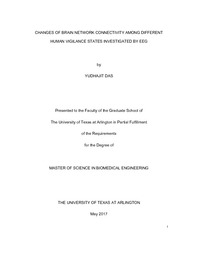
ATTENTION: The works hosted here are being migrated to a new repository that will consolidate resources, improve discoverability, and better show UTA's research impact on the global community. We will update authors as the migration progresses. Please see MavMatrix for more information.
Show simple item record
| dc.contributor.advisor | Liu, Hanli | |
| dc.creator | Das, Yudhajit | |
| dc.date.accessioned | 2017-10-02T13:45:23Z | |
| dc.date.available | 2017-10-02T13:45:23Z | |
| dc.date.created | 2017-08 | |
| dc.date.issued | 2017-09-11 | |
| dc.date.submitted | August 2017 | |
| dc.identifier.uri | http://hdl.handle.net/10106/26947 | |
| dc.description.abstract | Understanding the brain network connectivity associated with human vigilance states, to investigate the basic neural processes that underlie complex higher-order cognitive operations and functional domains, has become an important topic in biological science research. Also, there is growing concern about the prevalence and effects of sleep deprivation. Given the increasingly fast-paced nature of our society, the focus of the researchers is not only to identify the changes occurring within the brain during sleeping stages, but also to extract meaningful psycho-behavioral reason behind such change patterns which can lead to an improved understanding of brain activity during sleep which may further help in diagnosing various sleep disorders resulting in abnormal connectivity.
In this study, I performed data analysis of 64-channel electroencephalogram (EEG) taken from 18 human subjects to explore changes of brain networks/connectivity during different vigilance states, meaning when a person gradually shifts from eyes open to just eyes closed and later to sleep stages 1 and 2. A correlation method, a linear connectivity measure implemented using a free-downloadable software package, Brainstorm, was used to investigate the human brain functional connectivity in four frequency bands(i.e., delta, theta, alpha and beta band), under four vigilance states: eyes open, eyes closed, sleep stage 1, and sleep stage 2. Comparative analyses of the network properties and patterns of connection between the 4 stages were done using EEG topo plot analysis, a method for evaluating the similarity between signals in the frequency domain.
The pooled connectivity plots across all four bands show the location and number of significant connectivity changes in between different vigilance stages. Also, electrode-based topography across the entire human heads provides in-depth results, showing prevalent network connections and changes in long or short distances during transition from one vigilance state to another. My study reported meaningful convergence with previous sleep studies; my observations in each transition phase were discussed with speculations based on pre-existing researches. | |
| dc.format.mimetype | application/pdf | |
| dc.language.iso | en_US | |
| dc.subject | EEG | |
| dc.subject | Functional connectivity | |
| dc.subject | Sleep | |
| dc.subject | Resting | |
| dc.subject | Vigilance states | |
| dc.title | Change of Brain Network Connectivity among different Human Vigilance States investigated by EEG | |
| dc.type | Thesis | |
| dc.degree.department | Bioengineering | |
| dc.degree.name | Master of Science in Biomedical Engineering | |
| dc.date.updated | 2017-10-02T13:47:31Z | |
| thesis.degree.department | Bioengineering | |
| thesis.degree.grantor | The University of Texas at Arlington | |
| thesis.degree.level | Masters | |
| thesis.degree.name | Master of Science in Biomedical Engineering | |
| dc.type.material | text | |
Files in this item
- Name:
- DAS-THESIS-2017.pdf
- Size:
- 4.410Mb
- Format:
- PDF
This item appears in the following Collection(s)
Show simple item record


